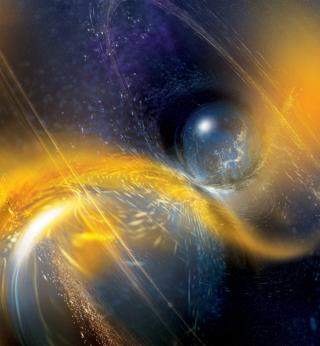Gravitational waves: Cosmic vibrations sensed from unusual star merger
Laser labs pick up a signal emanating from the collision of two dense, dead stars. …

 Image copyright NSF/LIGO
Image copyright NSF/LIGO 
Scientists have observed gravitational waves emanating from the collision of two dense, dead stars.
It’s the second time the international Ligo-Virgo collaboration of laser labs has picked up such a signal.
What makes this one different, though, is the combined mass of the two merging neutron stars – at three and a half times that of our Sun.
A coalescing system this big has never been seen in our galaxy and challenges researchers’ expectations.
All the previously known so-called binary neutron stars detected by radio telescopes have been no larger than 2.7 times the mass of the Sun.
“So, if you’re trying to explain how these systems are formed, you have to also explain why such a thing that we now know exists has never been seen in [our] galaxy. Or is there some reason radio surveys are blind to it?” said Katerina Chatziioannou from the Flatiron Institute, New York.
The union of the two neutron stars almost certainly produced a black hole.
Gravitational waves – Ripples in the fabric of space-time
- Gravitational waves are a prediction of the Theory of General Relativity
- It took decades to develop the technology to directly detect them
- They are ripples in the fabric of space-time generated by violent events
- Accelerating masses will produce waves that propagate at the speed of light
- Detectable sources include merging black holes and neutron stars
- Ligo/Virgo fire lasers into long, L-shaped tunnels; the waves disturb the light
- Detecting the waves opens up the Universe to completely new investigations
Dr Chatziioannou was speaking at the 235th meeting of the American Astronomical Society in Honolulu, Hawaii.
She is part of the worldwide scientific collaboration to detect the ripples in space-time that result when massive bodies accelerate.
The project uses three laser interferometers – in Washington State and Louisiana in the US, and near Pisa in Italy.
These facilities now routinely “listen” to the cosmos for the telltale vibrations that come from cataclysmic cosmic events.
Virtually all of the collaboration’s earlier detections have been the consequence of black hole collisions. The one exception was the neutron star merger sensed in August 2017.
That gravitational waves event was accompanied by a flash of light spread across many wavelengths, and analysed by multiple telescopes. In contrast, the new detection, made on 25 April last year, was void of a detectable signal in the electromagnetic spectrum.
This may just have been bad luck, however. The detection was made in the first instance in only one of the three labs – which makes it much harder to pinpoint on the sky where an event has occurred.
Normally, the collaboration likes to see a signal sensed across all its laser instruments, but such is the confidence now in the labs’ performance that scientists will always sit up and take notice when their algorithms post an alert from even just one lab.
“There’s clear separation between the noise we’ve seen the detectors producing and what signals look like,” Dr Chatziioannou told reporters. “This is what makes us confident that this is a real signal of astrophysical origin.”
Although on the day only the Ligo-Louisiana laser instrument flagged GW190425, as it has now been designated, subsequent reanalysis of the data showed the signal was present also in the recordings made by the Italian Virgo facility.
The gravitational waves event is calculated to have occurred about 500 million light-years from Earth – about four times further away than the 2017 neutron star merger (GW170817).
Scientists are already producing ideas for why the total mass of the new system is higher than previously observed.
Most of these suggestions relate to very special formation circumstances, but researchers concede the possibility that one or both objects could also be light-weight black holes.
This requires a whole new level of conjecture, however.
What is clear is how spectacularly well the laser interferometers are performing.
It is easy to forget that before the first historic detection of gravitational waves in September 2015, there were many who doubted the technical feasibility of sensing what are incredibly weak signals.
In the first two observing runs, which ran through periods in 2015-2017 – a total of 11 gravitational wave events were picked up. In the current campaign, which began in April last year and ends in April this year – more than 40 “candidate” detections have been made so far. About one a week.
These events still need further review before they can be confirmed, but the number speaks to the remarkable sensitivity and stability being achieved by the laser instruments.
Again, nearly all of the candidates are considered to be collisions of black holes.
- A laser is fed into the machine and its beam is split along two paths
- The separate paths bounce back and forth between damped mirrors
- Eventually, the two light parts are recombined and sent to a detector
- Gravitational waves passing through the lab should disturb the set-up
- Theory holds they should very subtly stretch and squeeze its space
- This ought to show itself as a change in the lengths of the light arms
- The photodetector captures this signal in the recombined beam
Jonathan.Amos-INTERNET@bbc.co.uk and follow me on Twitter: @BBCAmos


